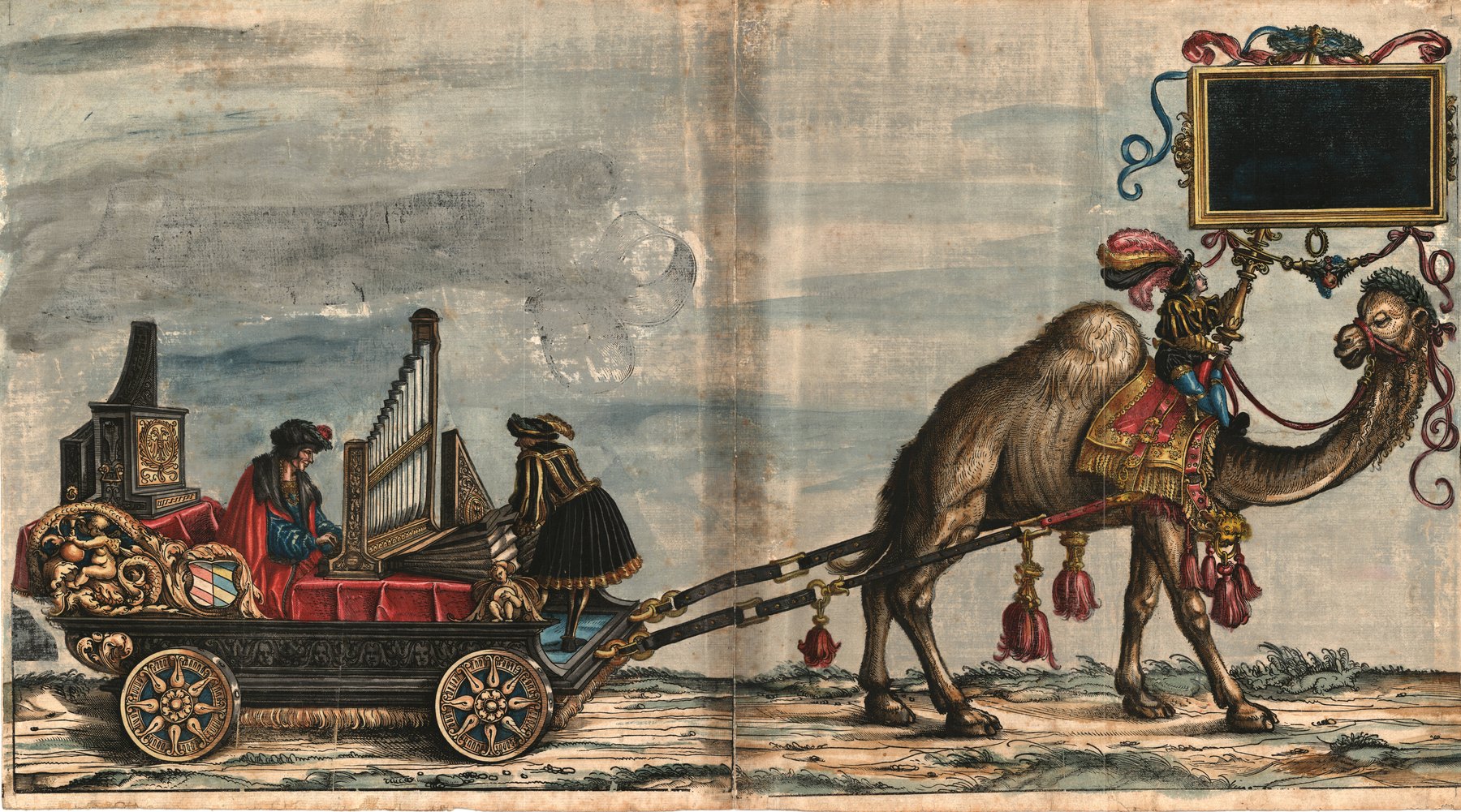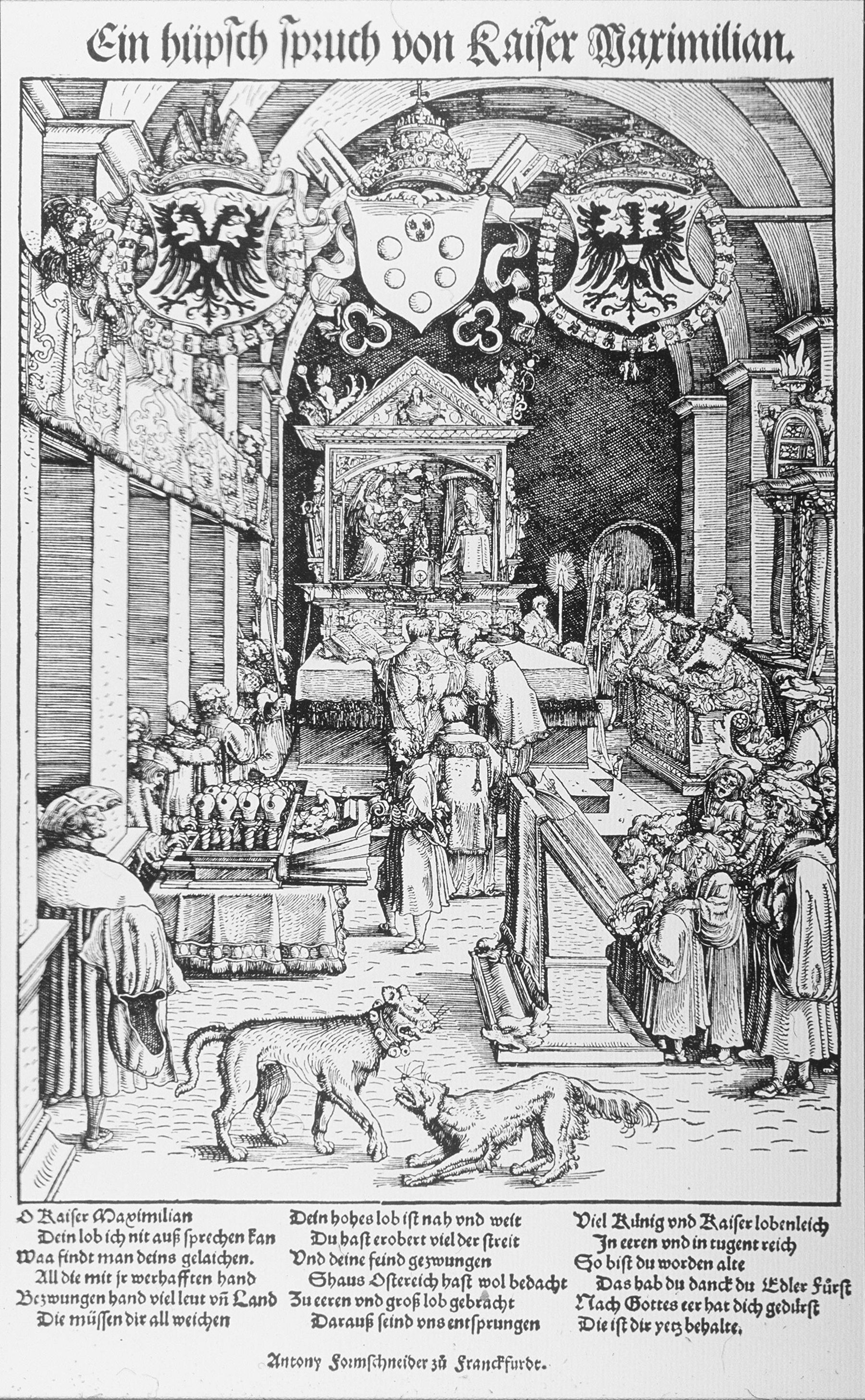“Musica Rigal vnd possetif”: Keyboard Instruments
The third musician carriage in the Triumphzug, titled “Musica Rigal vnd possetif” (Music: regal and positive organ) (» Abb. Triumphzug Regal) features only one musician: Paul Hofhaimer (1459–1537; » C. Orgeln und Orgelmusik; » C. Paul Hofhaimer). The image also includes a realistic detail, a bellows operator, who operates the bellows of the positive organ, without whom any organ would remain silent until the invention of the electrically driven air supply. Behind Hofhaimer, more keyboard instruments can be seen hidden in transport cases (according to the text, one is supposed to be a regal, the other could be a clavicytherium—a keyboard instrument with upright strings and a plucking mechanism like a harpsichord). Hofhaimer had been associated with the Habsburgs as an organist since his youth, serving Maximilian from 1490 and often traveling with him; his lament about having to wander like “ayn zigeyner” (like a gypsy) is famous (see » I. SL Life as an Emperor’s musician).[26] For this reason, portable keyboard instruments were necessary, but Hofhaimer also played on large church organs (» Orgel). On Maximilian’s behalf, he also supervised the construction of large organ works, such as in Innsbruck and Salzburg.[27] All these keyboard instruments had not only a practical musical function but also contributed to Maximilian’s reputation, as did the musicians who played them in his name. This is exemplified in the report of the envoys from Worms at the Imperial Diet in Cologne in 1505, describing Maximilian’s church attendance “mit sengern busunern pfyffern und orgeln und sunderdemselben mit aynem nüwen instrument der music uns gantz frembd kummen, auch demselben keynen nammen gebben” (with singers, trombonists, pipers, and organs, and also with a new musical instrument that was entirely unfamiliar to us and for which we had no name).[28] This is followed by a description of a regal with a greatly shortened resonator and reed pipes hidden inside the instrument’s body, making it seem to play without pipes. The sensation caused by such “new instruments” and the instrumental artists who played them is exemplified in the report on the festivities of the so-called Double Wedding in Vienna in 1515 (» D. Royal Entry):
“Hat der bischof von Wienn vnd kay. Ma. Capelln mit allerlay seitenspiln das hochambt gesungen / darunter vil newe vnd kunstliche saitenspil die man vor iar nit gehabt als das man Regal nennet vnd das ain Munch an alle pfeiffen erfunden / vnd aines das vogelgesang representiert / welche dan maister Paul organist der künstlichest in allen landen geschlagen hat.”[29]
(The Bishop of Vienna and the imperial chapel sang the High Mass with all kinds of instruments [saitenspil], including many new and artful instruments that had not been used before, such as the so-called regal without any organ pipes, invented by a monk, and another that imitated birdsong, which Master Paul, the most skilful organist in all lands, played.)
A similar understanding can be applied to the famous woodcut by Hans Weiditz, which shows Emperor Maximilian attending Mass (» Abb. Kaiser Maximilians Kapelle). Here, opposite the imperial singers, Hofhaimer sits at a striking organ instrument, the so-called “Apfelregal.” The curious name comes from the appearance of the pipes, “dass es wie ein Apfell vffm Stiel stehet” (which stand like an apple on a stem), that is, above the short reed pipes (the “stem”) stands a round resonator (the “apple”).[30] The otherwise quite loud regals thus sound softer and quieter, and look striking.
[26] See the letter from Paul Hofhaimer to Joachim Vadian on May 14, 1524; Moser 1966, 56.
[29] Nowak 1932, 84.
[30] Praetorius 1619, 148.
[1] For information on the Triumphzug, its different versions, and its complex history, see Appuhn 1979 and Michel/Sternath 2012; on its significance for Maximilian, see Müller 1982; on the relationship between depiction and reality, see Polk 1992; The quotation comes from the earliest surviving formulation of the iconographic program of the Triumphzug in 1512 in » A-Wn Cod. 2835, fol. 3v.
[2] Koczirz 1930/31, 531 f.
[4] Nedden 1932/33, 27 (quotation from the Augsburg Baumeisterbücher of 1491, the council’s account books for income and expenses).
[5] See Simonsfeld 1895, 267 f.
[6] See Strohm 2009, 98.
[7] Quoted in Waldner 1897/98, 2.
[8] Treitzsaurwein 1775, 78.
[9] See Schwindt 2012.
[10] She received 50 guilders “zu Irer vnderhaltung vnd Zerung” (for her maintenance and living) in June 1520 when the court chapel was dissolved after Maximilian’s death; Koczirz 1930/31, 535.
[11] Such as “Hannsen pfeiffer vnnd matheusen Trumelschlacher”, who were expressly paid for their services “bei Tanz” at the 1491 carnival; Waldner, 1897/98, 52.
[12] Appuhn 1979, 172 f.
[13] For a compilation of music-related illustrations, see Henning 1987, 69–94
[15] See Gombosi 1932/33; Heinzer 1999, 92 ff.
[16] Polk 1992, 86 (with references from Augsburg archives).
[17] See Kirnbauer 2005.
[18] See Kirnbauer 2003, 243–248 (including the following).
[20] According to payments in the Augsburg (D-As) Baumeisterbuch 103 (1509), fol. 24v, and 104 (1510), fol. 28; kindly communicated by Keith Polk.
[21] See Jahn 1925, 10 ff., and Kirnbauer 2000, 25 ff.
[22] Kirnbauer 1992, 131.
[23] Nedden 1932/33, 31.
[24] See Polk 1989a; Polk 1989b.
[25] Hintermaier 1993, 38.
[26] See the letter from Paul Hofhaimer to Joachim Vadian on May 14, 1524; Moser 1966, 56.
[29] Nowak 1932, 84.
[30] Praetorius 1619, 148.
[31] So the wording in the formulation of the iconographic program in » A-Wn Ms. 2835, fol. 8v.
[32] See Welker 1992, 189–194.
[33] Aich 1515, title page of the tenor partbook; for dating, see Schwindt 2008, 117 ff.
[34] See Bernoulli/Moser 1930, v–vii; McDonald/Raninen 2018.
[35] See Brinzing 1998, 137–154; Filocamo 2009.
[36] Senn 1954, 26, referring to Maximilian’s letter in A-Wn, Cod. 10100b, fol. 15r–v, edited in Kraus 1875, 39. I owe the correction in this context to Grantley McDonald, who also drew my attention to the ‘Lauerpfeif’ (KHM Vienna, Hofjagd- und Rüstkammer, A 74), a cannon with two pipes attached to the side of the gun barrel that can be used to produce whistling sounds; see Krammer 2025.
[37] » A-Wn, Mus. Hs. 41950; facsimile and description in Kirnbauer 2003. For lute tablatures of the next generation from the southern German-speaking area, see » H. Lautenisten und Lautenspiel (Kateryna Schöning).
[38] Gerle 1533, fol. IIv.
[39] See Moser 1966, 26 and 182, footnote 35.
[40] See Moser 1966, 137–140; Radulescu 1978, 66 f.; see also » C. Orgeln und Orgelmusik.
Recommended Citation:
Martin Kirnbauer: “Instrumentalkünstler am Hof Maximilians I.”, in: Musikleben des Spätmittelalters in der Region Österreich <https://musical-life.net/essays/instrumentalkunstler-am-hof-maximilians-i> (2016).

